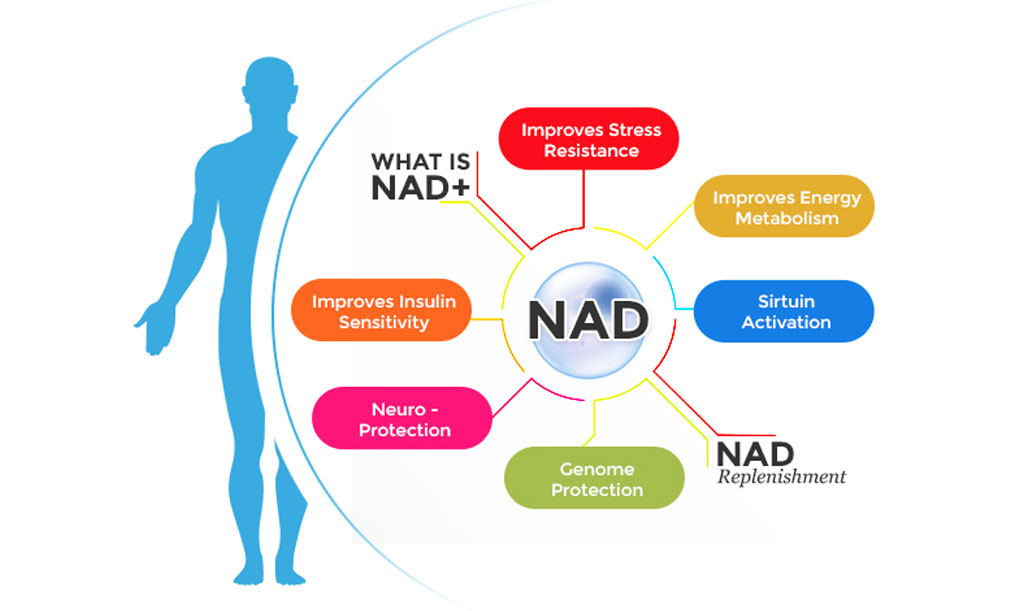What Is NAD+?

NAD+, or nicotinamide adenine dinucleotide, is scientifically defined as a naturally occurring co-enzyme of niacin. A close relative of vitamin B3, it aids in our bodies’ production of energy by converting energy obtained from food into cellular energy. The substance was discovered in 1906, and a recent study by Harvard researchers found that the NAD+ helped to reverse the effects of aging in mice. The body’s production and supply of NAD+ decreases with age, but Harvard professor of genetics David Sinclair, the study’s director, found that regular injections of NAD+ reversed the effects of vascular degeneration and muscle atrophy among the rodents studied. NAD+ essentially allows for the growth of new blood vessels, which keep muscles and other cells in the body from wasting away. It is also has been proven to increase neuroplasticity, the brain’s ability to repair itself.
The results of this study have led many anti-aging clinics to offer NAD+ therapy, which is also touted by providers for treating chronic fatigue syndrome, increasing focus and energy, aiding in detox from drugs and alcohol, increasing the metabolic rate, and improving cardiovascular health. While long term studies on the effects of NAD+ don’t yet exist, the medical establishment seems quite optimistic about its therapeutic uses.
How Does NAD+ Help Treat Addiction?

An interesting fact gleaned from research which has been conducted is that addicts typically have lower than average levels of NAD+ in their bodies. Some even speculate that lower than average levels of the substance might be one of the causes of dependence on alcohol and drugs. Some diseases that frequently co-occur with addiction also have the effect of depleting the body’s stores of NAD+, including post-traumatic stress, anxiety, and depression.
One provider of the therapy explains its use in detox and recovery like this: “NAD+ has a significant role in reducing the withdrawal effects by restoring the neurotransmitter balance, which shifts significantly after the drug that’s been withdrawn has been removed. As a result, the patient experiences almost no withdrawal symptoms whilst and after completing the infusion cycle.”
Dr. Mark Collins, a British physician and psychologist specializing in addictions, is more measured in his assessment, stating “I have now witnessed its use in many patients, and I am very impressed with the short-term results, what is clearly needed is more research, and in particular longer-term outcome studies.”
Testimonials from addicts who have used NAD+ to aid in their recovery are positive. A recent Vice article by a reporter who experimented with NAD+ treatment to combat cravings for alcohol offered a generally positive review. The reporter also interviewed a crack addict who found that “I’d be lying if I said the thoughts [about picking up] aren’t in my mind, and in my mind often, but that deep ‘urge’ that addicts will know about isn’t there any longer.”
While most NAD+ treatments rely on intravenous injections, the substance can also be obtained through foods and nutritional supplements. Milk, fish, mushrooms, whole grains, peanuts, and garden vegetables are all rich in this nutrient. And Dr. Collins notes that “It’s been known for decades that a high dose of vitamin B3—the ‘poor man’s’ way of elevating NAD levels—has a beneficial effect for alcoholics, both in terms of detoxification and, perhaps more importantly, in reducing craving and anxiety levels after detoxification.”
In fact, Bill Wilson (better known as Bill W., co-founder of Alcoholics Anonymous) experimented with large doses of NAD+ in 1960. He began taking 3000 mg of niacin (a vitamin which naturally contains NAD+) and found that it reduced the fatigue and depression which had plagued him for years. Excited about this discovery, “Wilson gave the same doses to 30 of his close friends in AA, hoping it could be replicated. Of the 30, 20 he later reported became free of anxiety, tension, and depression in one or two months.” Wilson tried to share news of his discovery and wrote a pamphlet, but the treatment was deemed too controversial by AA’s board of directors and his campaign was suppressed.
Decades Of Treatment Successes, No Long Term Studies

Flood doses of NAD+ have been used to treat addiction in South Africa since the 1960s, and the first clinic offering the treatment, the Springfield Wellness Center, founded by Psychotherapist Paula Mestayer and her Psychiatrist husband Richard, opened in America in 2001. They have since treated over 1000 patients, and Paula Mestayer says that the treatment “is not a cure, but rather maintenance,” and that many clients find it necessary to come back for booster doses. She also has found that the treatment is most effective when treating dependence on alcohol and opiates.
In spite of 70 years of evidence of the substantial benefits NAD+ therapy can offer addicts and those afflicted with a host of other ailments, there haven’t been long-term clinical studies on its efficacy and effects. It is reminiscent of ibogaine’s painstaking journey into the mainstream. While side-effects of NAD+ are usually limited to dizziness and perhaps a day or two of flu-like symptoms, we can’t be absolutely sure that NAD+ treatment is 100% safe in the long-term. But as the opioid epidemic rages on around the world and overdose tallies mount, investigating a promising treatment like NAD+ is indeed a sensible option.
At Tabula Rasa Retreat, we feel that it’s the responsibility of governments and addictions professionals to explore every avenue that could possibly lead to the end of addiction. And as we come to understand the cognitive and neurological processes which create the addicted mind, treatments such as NAD+ and ibogaine seem ever more sensible and promising.
For further information visit www.tabularasaretreat.com or call PT +351 965 751 649 UK +44 7961 355 530
